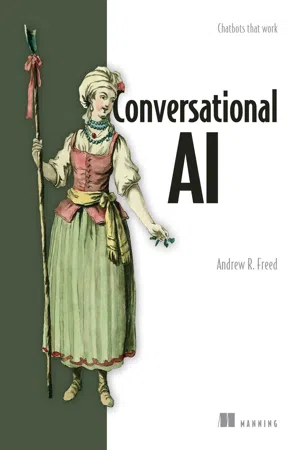
- 320 pages
- English
- ePUB (mobile friendly)
- Available on iOS & Android
Conversational AI
About This Book
"A thorough guide to the entire process of designing and implementing virtual assistants. Goes way beyond the technicalities." - Maxim Volgin, KLM Design, develop, and deploy human-like AI solutions that chat with your customers, solve their problems, and streamline your support services. In Conversational AI, you will learn how to: Pick the right AI assistant type and channel for your needs
Write dialog with intentional tone and specificity
Train your AI's classifier from the ground up
Create question-and-direct-response AI assistants
Design and optimize a process flow for web and voice
Test your assistant's accuracy and plan out improvements Conversational AI: Chatbots that work teaches you to create the kind of AI-enabled assistants that are revolutionizing the customer service industry. You'll learn to build effective conversational AI that can automate common inquiries and easily address your customers' most common problems. This engaging and entertaining book delivers the essential technical and creative skills for designing successful AI solutions, from coding process flows and training machine learning, to improving your written dialog. Purchase of the print book includes a free eBook in PDF, Kindle, and ePub formats from Manning Publications. About the technology
Create AI-driven chatbots and other intelligent agents that humans actually enjoy talking to! Adding intelligence to automated response systems saves time and money for you and your customers. Conversational AI systems excel at routine tasks such as answering common questions, classifying issues, and routing customers to the appropriate human staff. This book will show you how to build effective, production-ready AI assistants. About the book
Conversational AI is a guide to creating AI-driven voice and text agents for customer support and other conversational tasks. This practical and entertaining book combines design theory with techniques for building and training AI systems. In it, you'll learn how to find training data, assess performance, and write dialog that sounds human. You'll go from building simple chatbots to designing the voice assistant for a complete call center. What's inside Pick the right AI for your needs
Train your AI classifier
Create question-and-direct-response assistants
Design and optimize a process flowAbout the reader
For software developers. Examples use Watson Assistant and Python. About the author
Andrew R. Freed is a Master Inventor and Senior Technical Staff Member at IBM. He has worked in AI solutions since 2012.Table of Contents
PART 1 FOUNDATIONS
1 Introduction to conversational AI
2 Building your first conversational AI
PART 2 DESIGNING FOR SUCCESS
3 Designing effective processes
4 Designing effective dialogue
5 Building a successful AI assistant
PART 3 TRAINING AND TESTING
6 Training your assistant
7 How accurate is your assistant?
8 Testing your dialogue flows
PART 4 MAINTENANCE
9 Deployment and management
10 Improving your assistant
PART 5 ADVANCED/OPTIONAL TOPICS
11 Building your own classifier
12 Additional training for voice assistants
Frequently asked questions
Information
Part 1. Foundations
1 Introduction to conversational AI
- Listing the types of AI assistants and their platforms
- Classifying AI assistants
- Recognizing AI assistants that you already interact with
- Differentiating questions needing a simple response versus a process flow
- Describing how email clients learn from your actions
1.1 Introduction to AI assistants and their platforms
- Chat interfaces for customer service and guided buying
- Smartphones and connected homes that are controlled by voice (“Alexa, turn on the light!”)
- Email software that automatically sorts your mail into folders such as Important and Spam
| AI assistant type | Uses | Skills you’ll need to build one | Technology focus | Example platforms |
|---|---|---|---|---|
| Conversational AI (sometimes called a chatbot) | Customer service Guided buying experience New employee training | Designing and coding process flows with one or many steps Using conversational state to determine the next step Writing dialogue Classifying utterances into intents Extracting entities from utterances to support the intent Writing code to call external application programming interfaces (APIs) | Conversation and dialogue flow | IBM Watson Assistant Microsoft Azure Bot Service Rasa |
| Command interpreter | Natural language or voice interface to devices | Classifying statements into commands Extracting supporting parameters from a command statement Writing code to call external APIs | Classification and calling APIs | Apple Siri Amazon Alexa |
| Event classifier | Sorting email into folders Routing messages (such as emails) to an appropriate handler | Classifying messages based on message content and metadata Extracting many entities that support or augment the classification | Classification and entity identification | Google Gmail Natural Language Understanding services |
- Ease of use—Some platforms are intended for business users, and some are for software developers.
- APIs and integration—Does the platform expose APIs or have prebuilt integrations to third-party interfaces and tools? An AI assistant is usually integrated into a larger solution.
- Run-time environment—Some platfor...
Table of contents
- inside front cover
- Conversational AI
- Copyright
- dedication
- brief contents
- contents
- front matter
- Part 1. Foundations
- 1 Introduction to conversational AI
- 2 Building your first conversational AI
- Part 2. Designing for success
- 3 Designing effective processes
- 4 Designing effective dialogue
- 5 Building a successful AI assistant
- Part 3. Training and testing
- 6 Training your assistant
- 7 How accurate is your assistant?
- 8 Testing your dialogue flows
- Part 4. Maintenance
- 9 Deployment and management
- 10 Improving your assistant
- Part 5. Advanced/optional topics
- 11 Building your own classifier
- 12 Additional training for voice assistants
- Appendix. Glossary of terms and abbreviations
- index
- inside back cover